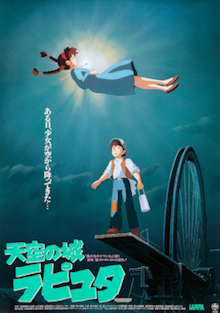This is officially the very first Studio Ghibli so it makes for a nice circle to complete our tour of their filmography with it. Unfortunately this is also one of their weakest ones. The early part of the film is downright boring, with violence that carries no weight and no clear theme apart from Hayao Miyazaki’s characteristic love of all flying things. Things improve once the characters actually reach Laputa and the film falls in the more familiar pattern that later Ghibli films would solidify. Still it’s never great and I hate how Sheeta is a passive princess character who keeps needing rescue.
An airship is attacked by a gang of flying pirates led by Dola. Their target is Sheeta, a girl being transported by the government, and the crystal pendant she wears. While trying to get away, Sheeta falls from the airship but the power of the crystal activates, allowing her to land gently. She is found by Pazu, a boy who lives in a mining town, who takes her to his home. The next morning, Dola’s gang arrives to continue searching for Sheeta. The two children flee with the help of the other villagers and Pazu is initially pleased when the army intervenes. But then Sheeta reveals that it was the government, led by an agent, Muska, who first kidnapped her from her home. After taking refuge in the mining tunnels, Sheeta explains that her parents were descended from the inhabitants of Laputa, a legendary flying island in the sky. They are captured by the army when they emerge from the tunnels and Sheeta is taken by Muska to see a damaged robot that fell from the sky long ago. His aim is to force Sheeta to help him find the way back to Laputa and use its power to conquer the world.
This film is crammed so full of the standard tropes that it’s nauseating: ancient long-lost civilization with superweapons, hidden princess, plucky hero and so on. Add to that the usual Ghibli quirks like making sure the children characters are either orphans or otherwise removed from parental protection and supervision, villain characters who later turn out to have a softer side and so on, and there’s a strong sense that we’ve seen all this before but in a less refined form here. There’s a fair amount of violence, plenty of explosions and property damage and such, yet the tension soon drains to nothing when it becomes obvious that no one will actually be seen to be killed or hurt on screen. It’s startling how little fear the characters have of heights, climbing ropes and roots, jumping across gaps, teetering on edges, all while they are presumably thousands of meters high up in the air. The net effect for me is that I found the scenario to be totally unbelievable and it’s hard to care about the characters or what’s going on.
It gets dramatically better once the characters actually arrive at Laputa. The camera becomes much more dynamic, sweeping over the vistas of the floating island and even the quality of the art kicks up a notch. It’s painfully obvious that this is really what Miyazaki was interested in making all along. At least with the government soldiers being available as disposable mooks in these scenes, the violence feels a little more real and there is a clearer sense of what is at stake. The story still ducks the question of why Laputa ever fell into ruin and lies abandoned given the mastery of technology of the civilization that built it. The lesson it imparts seems to be the pessimistic one that humanity simply doesn’t deserve to wield such power. Finally Ghibli films usually avoid including overtly romantic relationships but it’s hard to see Sheeta and Pazu as being anything else. I found it off-putting and ridiculous as Miyazaki goes to such lengths to keep his protagonists as children when they’re cast into roles that require them to be older.
For all these reasons, I found this to be a weak film. It’s less refined and not as pretty as their later films but also lacks the boldness and originality of Nausicaä. On the top of that all, it’s not even particularly funny and I doubt that anyone would find its characters memorable. It’s easily one of the most easily skipped Ghibli productions.
